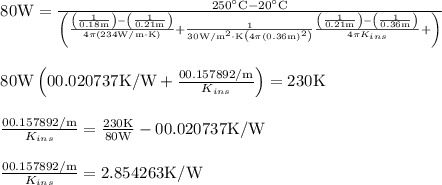
Engineering, 29.10.2019 05:31 livirose1514
Ahollow aluminum sphere, with an electrical heater in the center, is used in tests to determine the thermal conductivity of insulating materials. the inner and outer radii of the sphere are 0.18 and 0.21 m, respectively, and testing is done under steady-state conditions with the inner surface of the aluminum maintained at 250°c. in a particular test, a spherical shell of insulation is cast on the outer surface of the sphere to a thickness of 0.15 m. the system is in a room for which the air temperature is 20°c and the convection coefficient at the outer surface of the insulation is 30 w/m2 ⋅ k. if 80 w are dissipated by the heater under steady-state conditions, what is the thermal conductivity of the insulation?

Answers: 1


Another question on Engineering

Engineering, 04.07.2019 12:10
On a average work day more than work place firs are reorted
Answers: 1

Engineering, 04.07.2019 18:10
Hydraulic fluid with a sg. of 0.78 is flowing through a 1.5 in. i.d. pipe at 58 gal/min. the fluid has an absolute viscosity of 11.8 x 105 lbf-sec/ft2. is the flow laminar, turbulent or within the critical range? give both a numerical reynolds number and a term answer.
Answers: 3

Engineering, 04.07.2019 18:10
Courses that are developed by subject matter experts, internal or extemal to the college or university. these programs are marketed by the school (clo2) marks a)-vocational schools b)-vendor training c)-colleges & universities d)-continuing education programs
Answers: 2

Engineering, 04.07.2019 18:20
How much power could a wind turbine produce if it had the following specifications? cp = 0.45 -d=1.2kg/m3 d=50m v 5m/s
Answers: 2
You know the right answer?
Ahollow aluminum sphere, with an electrical heater in the center, is used in tests to determine the...
Questions



History, 05.10.2019 12:30

Mathematics, 05.10.2019 12:30

Mathematics, 05.10.2019 12:30

History, 05.10.2019 12:30



Mathematics, 05.10.2019 12:30


Mathematics, 05.10.2019 12:30



Mathematics, 05.10.2019 12:30

History, 05.10.2019 12:30

Biology, 05.10.2019 12:30



Physics, 05.10.2019 12:30



 is the thermal resistance for conduction, K is the thermal conductivity of the material,
is the thermal resistance for conduction, K is the thermal conductivity of the material,  is the inner radius of the sphere, and
is the inner radius of the sphere, and  is the outer radius of the sphere.
is the outer radius of the sphere.
 is given by
is given by


 is aluminum’s thermal conductivity at
is aluminum’s thermal conductivity at  }
}


 is thermal resistance for convection and A is the cross-sectional area normal to the direction of flow of heat energy
is thermal resistance for convection and A is the cross-sectional area normal to the direction of flow of heat energy


 where t is thickness of insulation
where t is thickness of insulation

 is total thermal resistance
is total thermal resistance

 as 234W/m.K
as 234W/m.K

 } is the steady state heat transfer rate in-between the inner surface of the sphere and the ambient air.
} is the steady state heat transfer rate in-between the inner surface of the sphere and the ambient air.
 for
for 




